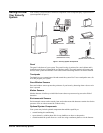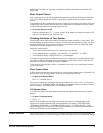
Concord 4 Series Security Systems 5
If the system goes into a fire alarm automatically:
1. Immediately exit the building.
2. Notify the fire department from a safe location (if system is not monitored).
If you discover a fire emergency before the system goes into alarm automatically:
1. Press and hold both Fire button(s) for 2 seconds on the nearest touchpad or activate a
manual fire pull.
2. Evacuate all occupants from the building.
3. Notify the fire department from a safe location (if system is not monitored).
Warning!
Do not re-enter the building if sirens stop. The sirens in your system are pro-
grammed to stop after a certain amount of time. This does not mean it is safe to re-
enter the building. Only fire department personnel can determine when it is safe to
re-enter.
Clearing Alarms and Resetting Smoke Detectors
Wireless smoke sensors reset themselves automatically, once they are clear of smoke. Some
hardwired smoke detectors must be manually reset once they are clear of smoke. Check with
your installer for reset procedures for your system.
To clear an alarm condition caused by wireless smoke sensors:
Press 1 + CODE. Touchpads display the sensor(s) that caused the alarm (alarm memory). If
sirens were still active, they will stop.
To clear an alarm condition caused by hardwired smoke sensors and reset the detec-
tors:
1. Press 1 + CODE. Touchpads display the zone(s) that caused the alarm (alarm memory). If
sirens were still active, they will stop. The light on the smoke detector remains lit until it is
reset.
2. Press 1 + CODE again to reset hardwired detectors and clear alarm memory.
Note
In some cases your installer may have installed a smoke detector reset switch. If so, use Step 2 only to
clear alarm memory. Press and hold the switch for at least one second, then release it to reset smoke
detectors.
The system may sometimes go into alarm again after clearing the alarm and resetting smoke
detectors. This usually indicates there is still smoke in the chamber inside the detector, even
though you may not see any smoke near it.You may need to clear this condition by fanning the
air near the detector for a few seconds, then use the appropriate procedure above again.
Preventing Accidental Alarms
Most accidental alarms occur when leaving the premises after arming the system, or upon return-
ing, before disarming the system.
For example, if you arm the system then run upstairs for something you forgot, the Exit Delay
time may expire. Once the Exit Delay expires, opening an armed door or moving in front of a
motion detector will cause an alarm.
Guidelines for Preventing Accidental Alarms
The following guidelines will go a long way toward preventing accidental alarms.
• Close all doors and windows before leaving.
• Gather your belongings so you can exit immediately after arming the system.
• Always enter and exit within the programmed delay times.
• Make sure you leave through a designated delay door.
• Disarm your system immediately upon entry.
• Get familiar with all devices in your security system and learn how each one operates.
• If you have pets, ask your installer if you need pet lenses in your motion detectors.


















